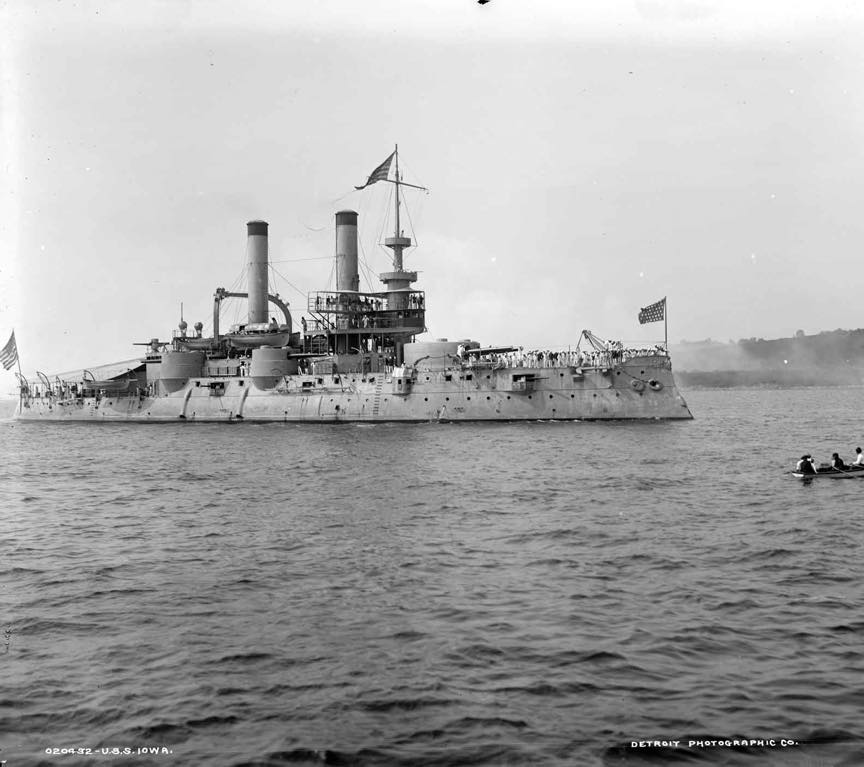USS Iowa BB-4

(BB-4: dp. 11,346; l. 360'; b. 72' 2"; dr. 24'; s. 17 k.; cpl. 727; a. 4 12", 8 8", 6 4", 20 6-pdrs., 4 1-pdrs., 24 14" tt)
The second Iowa (BB-4) was laid down by William Cramp & Sons, Philadelphia, on 5 August 1893, launched on 28 March 1896; sponsored by Miss M. L. Drake, daughter of the governor of Iowa; and commissioned on 16 June 1897, Captain W. T. Sampson in command.
After a shakedown off the Atlantic Coast, Iowa was assigned to the Atlantic Fleet and was ordered to blockade duty on 28 May 1898, off Santiago de Cuba. On 3 July 1898, she was the first to sight the Spanish ships approaching and fired the first shot in the Battle of Santiago de Cuba. In a 20-minute battle with Spanish cruisers Maria Teresa (flagship) and Oquendo, her effective fire set both ships aflame and drove them onto the beach. Iowa, continuing the battle in company with the converted yacht Gloucester, sank the Spanish destroyer Pluton and so damaged destroyer Furor that she ran aground. Iowa then turned her attention to the Spanish cruiser Vizcaya which she pursued until Vizcaya ran aground. Upon the conclusion of the battle, Iowa received on board Spanish Admiral Cervera and the officers and crews of the Vizcaya, Furor, and Pluton.
After the Battle of Santiago, Iowa left Cuban waters for New York, arriving on 20 August 1898. On 12 October 1898, she departed for duty in the Pacific, sailed around Cape Horn, and arrived in San Francisco on 7 February 1899. The battleship then steamed to Bremerton, Wash., where she entered drydock on 11 June 1899. After repairs, Iowa served in the Pacific Squadron for 2½ years, conducting training cruises, drills, and target practice. Iowa left the Pacific early in February 1902 to become the flagship of the South Atlantic Squadron. She sailed for New York on 12 February 1903 and decommissioned on 30 June 1903.
Iowa recommissioned on 23 December 1903 and joined the North Atlantic Squadron. She participated in the John Paul Jones Commemoration ceremonies on 30 June 1905. Iowa remained in the North Atlantic until she was placed in reserve on 6 July 1907. She decommissioned at Philadelphia on 23 July 1908.
Iowa recommissioned on 2 May 1910 and served as a training ship and as a component of the Atlantic Reserve Fleet. During the next four years, she made a number of training cruises to Northern Europe and participated in the Naval Review at Philadelphia from 10 to 15 October 1912. She decommissioned at Philadelphia Navy Yard on 27 May 1914. At the outbreak of the First World War, Iowa was placed in limited commission on 23 April 1917. After serving as a Receiving Ship at Philadelphia for six months, she was sent to Hampton Roads, Va., and remained there for the duration of the war, training men for other ships of the Fleet, and doing guard duty at the entrance to Chesapeake Bay. She decommissioned for the final time on 31 March 1919.
On 30 April 1919, Iowa was renamed Coast Battleship No. 4, and was the first radio-controlled target ship to be used in a fleet exercise. She was sunk on 23 March 1923 in Panama Bay by a salvo of 14-inch shells.
BB-53 was laid down as Iowa at Newport News Shipbuilding & Dry Dock Co. on 17 May 1920, but on 8 February 1922, work was suspended when the ship was 31.8 percent complete. Construction was cancelled on 17 August 1923 in accordance with the terms of the Washington Treaty limiting naval armaments. She was sold for scrap on 8 November 1923.
 >
>